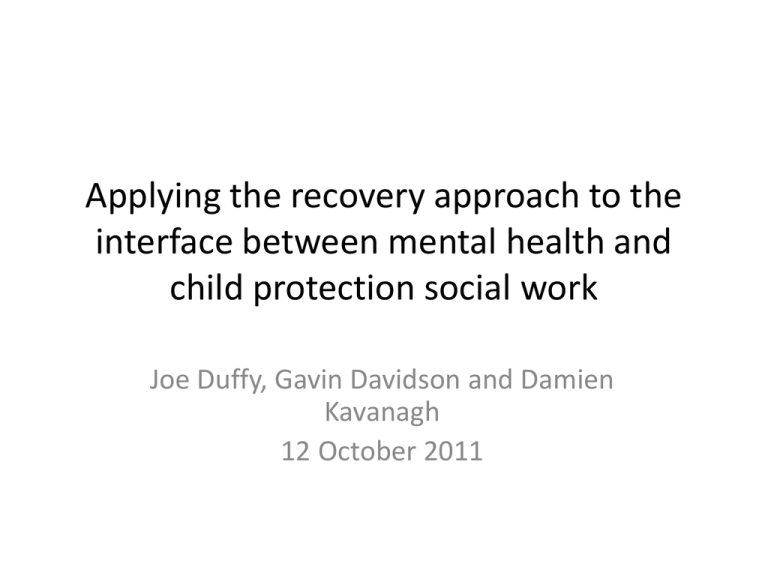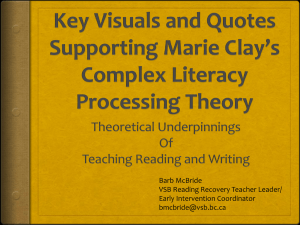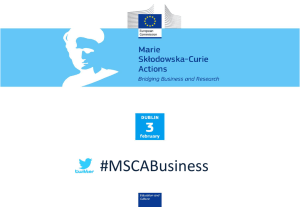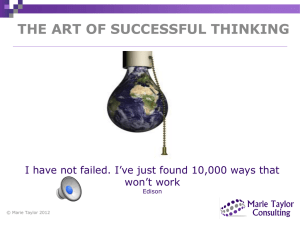Applying the recovery approach to the interface between mental
advertisement

Applying the recovery approach to the interface between mental health and child protection social work Joe Duffy, Gavin Davidson and Damien Kavanagh 12 October 2011 Introduction At a time when social work continues to experience scrutiny in the wake of several child abuse tragedies, this workshop proposes that more positive approaches to engagement, risk assessment and management may lead to better outcomes in working with families experiencing parental mental health problems and child protection concerns. Objectives In proposing that the recovery approach can inform the processes of engagement and assessment at the mental health and child care interface, this workshop presentation will: 1. 2. 3. Provide a critical overview of the recovery approach which compares it with approaches typifying interventions in child protection work to date. Refer to relevant research and inquiries which have provided a range of recommendations for how to more effectively respond to cases where there are issues around parental mental health problems and child protection. Apply the recovery approach to practice and critically discuss the issues involved in its application to the interface. Background • • • • • The relationship between parental mental health problems and child protection is well established (Rutter & Quinton 1984; Falkov 1996; Stallard et al. 2004). However, we still experience serious challenges in effectively responding at this interface (SCIE, 2009). Many child abuse enquiries make explicit the on-going need for professionals to improve how they work collaboratively in their responses to child protection cases (Duffy and Collins 2010). The benefits of multi-agency working at the interface between mental health and child protection are also quite clear with such joined up approaches yielding more creative pooling of skills and knowledge between workers culminating in improved solutions, efficiencies in service delivery, cost effectiveness and alleviated stress for workers (Darlington et al. 2005). The Recovery Approach, underpinned by engagement principles, may offer an alternative to workers involved in this interface at a time when existing responses tend to be both risk avoidant and overtly managerial (Munro, 2010). Recovery approach - definitions • Recovery can occur in the context of continuing symptoms or disabilities. This definition is the focus of the recovery approach and is about recovery of hope and ambition for living full and purposeful lives • Deegan (1988) defines recovery as, ‘a process, a way of life, an attitude, and a way of approaching the day’s challenges’ • Recovery may involve many stages, and inevitably setbacks and uncertainty, and has been described as, ‘an uncharted, unpredictable, and personal journey’ (Antony Sheehan, NIMH, 2002) History of the recovery approach • Roberts and Wolfson (2006) date the origins of recoveryoriented practice to the Tuke family who established The Retreat in York at the turn of the 18th century. • William Tuke, a Quaker and a lay reformer, set out to create a family-like healing and spiritual environment for members of the Society of Friends. • The Tukes showed that moral or psychological forms of treatment in a work-oriented, peaceful and pleasant environment could replace physical restraint. History of the recovery approach • More recently, the recovery approach has emerged from the writings of people who used services in the 1980s in the US, and in the 1990s in the UK • Many wrote about coping with symptoms, getting better, and regaining a satisfactory sense of personal identity that was not defined by illness experience Key recovery themes • Recovery is fundamentally about a set of values related to human living applied to the pursuit of health and wellness. • Recovery involves a shift of emphasis from pathology, illness and symptoms to health, strengths and wellness. • Hope is of central significance. If recovery is about one thing it is about the recovery of hope, without which it may not be possible to recover and that hope can arise from many sources, including being believed and believed in, and the example of peers. Possible implications of recovery approach for services • • • • Role of service user Role of multi-disciplinary team Ethos of services Focus of assessment, planning and intervention • Organisation of services The Recovery Approach and User Engagement • • • • Priebe et al. (2005), in a study of assertive outreach services, reported that people are more likely to engage with services if they feel listened to, their views have an effect on the care offered and they have some power to make decisions about the services they use. The recovery approach therefore suggests that positive engagement with clients rather than coercion is the most effective means of reducing risk and improving mental health and functioning. Ryan and Morgan (2004) argue “…that (paradoxically) the best route to safety may be the one that seeks to empower users, not control them…”” (p.ix). Laurance (2003) argues that engaging service users is crucial in this field, “The most effective way to improve the safety of the public and the care of those who are mentally ill is to devise services that genuinely engage users and meet their desire for greater control so that they are encouraged to seek treatment and lead stable, risk-free lives” (pxxi). in practice, the implementation of a participatory approach may present serious challenges for social workers, who may feel their status as expert may be undermined (Levin and Weiss-Gal 2009). They may also be attempting to engage service users who are reluctant to have any involvement from social work and harbour genuine scepticism about service users’ capabilities in making choices. What do we mean by the Interface? • Refers to the direct exchanges between mental health and child care and how all of the people involved engage with service users to ensure the best possible outcomes. • Darlington et al. (2005) classify the issues causing difficulties at this interface into two main groups. The first group contains the issues relating to collaboration which could be relevant regardless of the service user group. The second group covers the specific challenges involved in inter-agency working with people with mental health problems and children with protection needs. This group includes the nature of mental health problems and the difficulties involved in trying to balance the often conflicting needs of parents and children. SCIE (2009), however, has attempted to summarise the possible issues and challenges characterising current practice in the interface and has identified factors at each stage of the process in screening, assessment, care planning, care provision and review. • • Screening • • • • In regard to screening, problems can be evidenced by social workers lacking enquiry skills in asking appropriate questions. Additionally, problems occur in social workers not being attuned to the functions of other professionals around mental health and child protection. The fear, mistrust and suspicion with which social workers are sometimes viewed can also act as inhibitors as well as the negative perceptions accompanying mental illness diagnosis itself. There are also issues around parents fearing the loss of parental responsibility and children having fears about separation from their parents. Research conducted by Stanley et al. (2003) revealed worrying degrees of mistrust among mothers with mental health problems towards their child care social workers: “the relationship with this service was most often characterised as one in which trust was absent, communication was poor” (p. 216). This absence of trust was fundamentally linked with the fear of their children being removed into care. As a result, important information was withheld by mothers, resulting in both inadequate assessments and a lack of support. Assessment • Limited knowledge around mental health problems may impede child care social workers from appreciating their impact on parenting when conducting assessments. It is at this axis where inter-professional working across the interface would seem imperative, particularly in situations where families are affected by a multiplicity of adversities. Stanley et al. (2003) suggested dyadic key worker roles in mental health and child care as a solution where: “each professional could offer an insight into the procedures, legal provisions and interventions specific to their service” (p. 217). Planning • In the context of planning, whilst closer collaborative working may help professionals in untangling multi-faceted familial problems, the difficulties in the perception and interpretation of such problems at the individual level of the professional should not be understated. With a focus on the needs of the parent, the mental health professional may, for example, struggle to recognise the inherent and underlying risks of harm to the child whilst the child care social worker may question any possibility of positive change on the part of the parent. Some commentators also suggest that a tendency towards ‘risk-focused and risk aversive intervention is now an engrained feature of practice with children and families (Frost and Parton, 2009). Why is Interface Working Necessary? • Turning to how social workers respond to instances where there is an interface between child protection and mental health concerns, Reder and Duncan (1999, p. 56) used the term ‘assessment paralysis’ to typify the uncertainty which social workers can often exhibit in terms of determining their professional response. In such cases, priority was disproportionately given to the psychiatric issues rather than the child protection dimensions. • Consequently, these authors call for an emphasis to be placed on the behaviour of parents as opposed to their psychiatric diagnosis. Such a refocused response would necessarily involve examining the parents’ expression of thoughts and feelings within the overarching paradigm of behaviour. • Reder and Duncan aptly call for mental health professionals to ‘think family’ when approaching the dual concerns of mental health problems and child protection. Within this, there is also a plea to see the service user in their ecological context of connections and relationships to children and other family members. Such a systemic response would necessarily entail engagement with the important interests of significant others such as children. Case Study Marie (36) is a single parent with two children, Jamie (Aged 14) and Clare (Aged 9). Marie’s relationship with her husband, Clive, ended two years ago after she found out that he was having an affair. Clive continues to see the children regularly and Marie continues to live in the marital home in the outskirts of the city. Marie has been suffering from depression, anxiety and ruminations for the past ten years and mental health services are involved. Marie has attempted suicide on two occasions in the past four years and following these incidents has been admitted to a mental health in-patient unit. Marie has a very good friend, Patricia, who was able to look after the children during these times. Patricia has become concerned about Marie, who told her recently that she was hearing voices which were telling her to “end it all and take the children with her”. Marie doesn’t think she is going to get better and that mental health services won’t help her. She also fears if she is not here, the children will be taken into care by social workers. Marie is visited by a Community Psychiatric Nurse (CPN) and Patricia has phoned him to express concerns about what she has been told. The CPN then makes contact with his colleagues in the Child Care team as well as the mental health social worker. Application to Practice • • • As Darlington et al. (2005) have highlighted, obstacles to effective interface working may relate to the general organisational issues such as time, communication and differing systems and/or to the specific nature of the mental health problems and child care concerns. The recovery approach suggests that if initial attempts to engage Marie were to lead with and focus on the risks, this may undermine the development of a trusting relationship with Marie and her family which is needed to enable a more comprehensive assessment of the possible risks It is suggested therefore, that in order to achieve meaningful engagement, it is more effective to work with Marie in a way that communicates hope and acknowledges the strengths and resilience in her and her family. This is not to say that the risks do not need to be assessed but that the recovery approach is potentially a more constructive way of achieving this. Application to Practice • Building on Stanley et al.’s (2003) suggested dyadic key worker roles, a triadic approach to Marie’s recovery journey will help incorporate the views of Marie, her family members and those involved in offering support and intervention. • The welfare of the child as paramount is also core to informing intervention in this family’s life. In supporting and engaging with the family, it is therefore important that information is exchanged not only between all of the significant individuals in Marie’s life but also with other practitioners. • Partnership, as a central social work value, underpins both child protection legislation and the recovery approach. The practitioner, therefore, in conveying honesty with Marie in a respectful and sensitive manner, should explore her understanding of the impact that these experiences and her thoughts could have on her family. The fact that Marie has disclosed the content of the voices she is hearing to Patricia suggests that she is self-aware and is acting proactively in protecting her children. • It is important therefore for the practitioner to understand and convey that the voices and experiences affecting Marie form her ‘reality'. To challenge the validity of these, or to overemphasise their negative impact would exacerbate any pre-existing vulnerability. Application • Working in a holistic way with Marie and significant others in her life will therefore aid the worker in developing a more robust understanding of Marie’s experiences and support needs. An effective plan should be developed which involves as many of those people that Marie feels are important to her. Within this, it is important to note the existence of arrangements for compulsory intervention in Marie’s life from a child protection and mental health perspective, if these are deemed necessary. Should Marie warrant compulsory admission to mental health services, an explanation must be offered in a humane and sensitive manner as to the nature and purpose of such intervention. This information must also be provided to significant others in Marie’s life, within appropriate sensitivities around confidentiality. Application • Adopting a recovery approach assists in undermining any sense of vulnerability and powerlessness an individual may perceive. That is not to say however that the relevant key worker for this family should assume that once a recovery-oriented approach is adopted, stigma and social exclusion will cease to impact on their lives. Adopting this approach necessitates a sense of openness and acceptance on the part of Marie and others of the reality of their experiences, which can be achieved by the worker’s skills and commitment to user engagement. Conclusion • Central to applying the recovery approach to the mental health/child protection interface is the promotion of user engagement, partnership working and a commitment to strengths and resilience based thinking. • The recovery approach can positively blend within existing preventative and re-focussed ways of working with families aimed at helping to better build capacity to sustain families together. • The recovery approach as a form of family support and engagement may therefore offer a more effective means of protecting children, through its inherent focus on an all family perspective, where risk is assessed and managed in a spirit of collaboration, empowerment, partnership and openness. A New Model • In conclusion we would therefore propose that a ‘family recovery approach’ should be included in any practice guidance/protocols arising from implementation of SCIE’s Think Family. Whilst this paper has addressed some of the challenges that could accompany implementation, the community and societal context for interface working as well as micro-level practice issues will also require further debate and consideration. References • • • • • • • • • • • • • • • • • Darlington, Y., Feeney, J.A. and Rixon, K. (2005) Practice challenges at the intersection of child protection and mental health. Child and Family Social Work 2005, 10, pp. 239–247. Deegan, P. (1996) Recovery as a journey of the heart. Psychiatric Rehabilitation Journal, 11, 11 –19. Duffy, J and Collins, M.E. (2010) Macro impacts on caseworker decision-making in child welfare: a cross-national comparison. European Journal of Social Work. 13(1): 35-55 Falkov, A. 1996.A Study of Working Together Part 8 Reports: Fatal Child Abuseand Parental Psychiatric Disorder. Department of Health: London. Frost, N and Parton, N (2009) Understanding children’s social care: Policy, politics and practice. London. Sage Laurance, J. (2003). Pure madness: How fear drives the mental health system. Abingdon: Routledge. Levin, L. And Weiss-Gal, I. (2009) ‘Are Social Workers Required to Engage in Participatory Practices? An Analysis of Job Descriptions’, Health and Social Care in the Community, 17 (2), 194 – 201. Munro, E (2010) Learning to Reduce Risk in Child Protection. British Journal of Social Work.Vol 40. pp, 1135-1151 Priebe, S., Watts, J., Chase, M., &Matanov, A. (2005). Processes of disengagement and engagement in assertive outreach patients: Qualitative study. British Journal of Psychiatry, 187, 438-443. Reder and Duncan (1999) Lost Innocents – A Follow-Up Study Of Fatal Child Abuse. London and New York.Routledge. Roberts, G., Davenport, S., Holloway, F. &Tattan, T. (Eds.)(2006) Enabling Recovery: The principles and practice of rehabilitation psychiatry.London: Gaskell/Royal College of Psychiatrists. Rutter, M. & Quinton, D. (1984) Parental psychiatric disorder:effects on children. Psychological Medicine, 14, 853–880. Ryan, P., & Morgan, S. (2004). Assertive outreach: A strengths approach to policy and practice. London: Churchill Livingstone. Social Care Institute of Excellence (2009) Think child, think parent, think family: a guide to parental mental health and child welfare. London: SCIE. Stallard, P., Norman, P., Huline-Dickens, S., Salter, E. &Cribb,J. (2004) The effects of parental mental illness upon children:a descriptive study of the views of parents and children. ClinicalChild Psychology and Psychiatry, 9, 39–52. Stanley N, Penhale B, Riordan D, Barbour RS, Holden S(2003)aChild Protection and Mental Health Services. University of Bristol Press: Bristol. Stanley N, Penhale B, Riordan D, Barbour RS, Holden S (2003)b Working on the interface: identifying professional responses to families with mental health and child-care needs. Health and Social Care in the Community.11(3), 208-218











